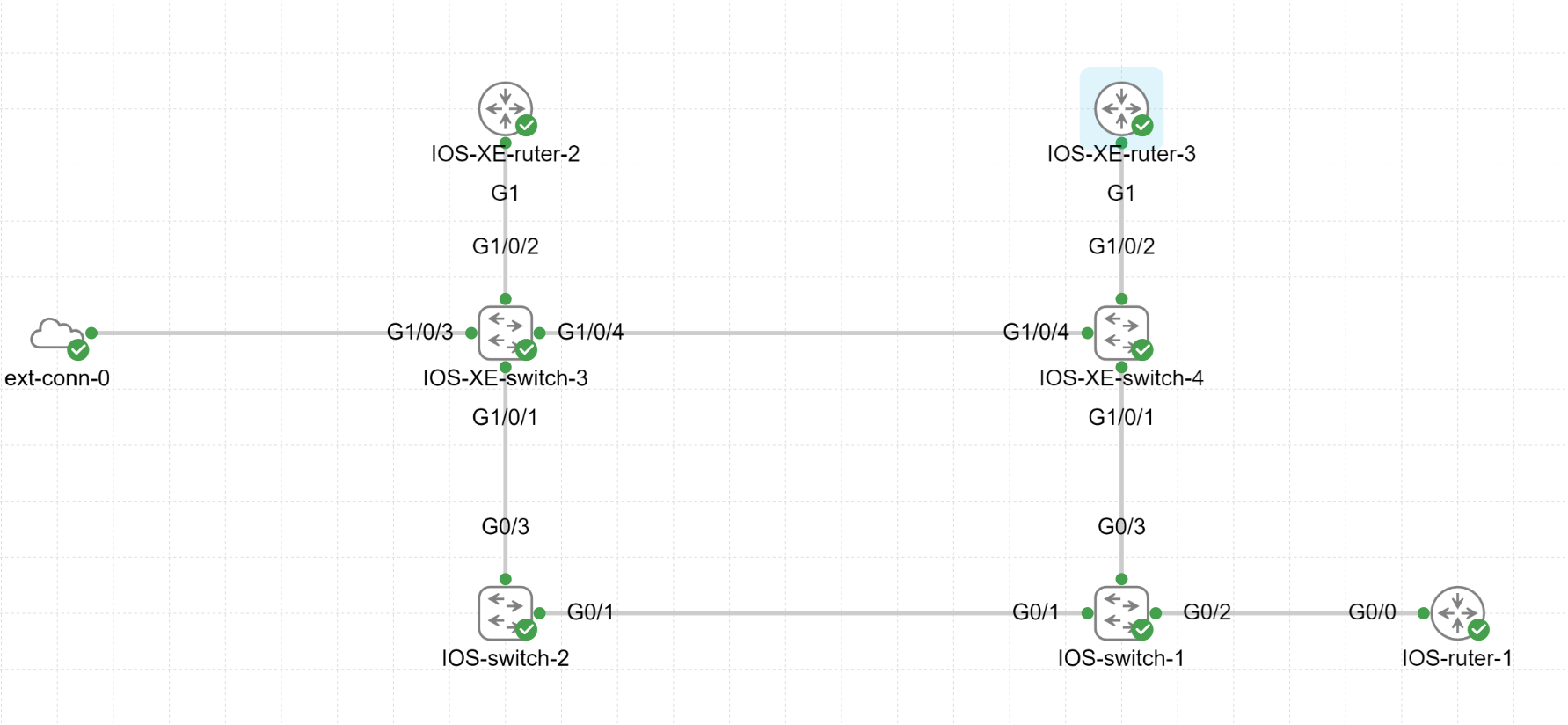Ansible - Inventory
Ansible bruker Inventory-fil for å vite hvilke hoster du har i din ifrastruktur.
Inventory-filen er i INI-format eller YAML-format og kan inneholde grupper og variabler.
I lab miljøet har jeg en WSL Ubuntu 22.04 og en Cisco CML2 server.
Det er 2 ios switcher, 2 ios xe switcher, 2 ios xe routere og 1 ios ruter i laben.

Under kan du se en eksempel på en Inventory-fil i INI-format og YAML-format for alle nodene i laben.
Filen er i INI-format eller YAML-format og kan inneholde grupper og variabler.
Unngå mellomrom, bindestreker og foregående tall i grupper
Det fungerer men du får en feilmelding når du kjører ansible-playbook kommandoen.
[WARNING]: Invalid characters were found in group names but not replaced, use -vvvv to see details
I INI-format ser filen slik ut:
[IOS_switch_1] IOS_switch_1 ansible_host=10.170.0.231 [IOS_switch_2] IOS_switch_2 ansible_host=10.170.0.232 [IOS_XE_switch_3] IOS_switch_3 ansible_host=10.170.0.233 [IOS_XE_switch_4] IOS_XE_switch_4 ansible_host=10.170.0.234 [IOS_ruter_1] IOS_ruter_1 ansible_host=10.170.0.251 [IOS_XE_ruter_2] IOS_XE_ruter_2 ansible_host=10.170.0.252 [IOS_XE_ruter_3] IOS_XE_ruter_3 ansible_host=10.170.0.253
I YAML-format ser filen slik ut:
all:
hosts:
IOS_switch_1:
ansible_host: 10.170.0.231
IOS_switch_2:
ansible_host: 10.170.0.232
IOS_XE_switch_3:
ansible_host: 10.170.0.233
IOS_XE_switch_4:
ansible_host: 10.170.0.234
IOS_ruter_1:
ansible_host: 10.170.0.251
IOS_XE_ruter_2:
ansible_host: 10.170.0.252
IOS_XE_ruter_3:
ansible_host: 10.170.0.253
Det finnes to spesielle grupper i Ansible Inventory-filen: all og ungrouped. Gruppen all inneholder alle hoster i Inventory-filen. Gruppen ungrouped inneholder alle hoster som ikke er i noen gruppe.
ansible-inventory -i inventory_enkel.yaml --list
{
"_meta": {
"hostvars": {
"IOS_XE_ruter_2": {
"ansible_host": "10.170.0.252"
},
"IOS_XE_ruter_3": {
"ansible_host": "10.170.0.253"
},
"IOS_XE_switch_3": {
"ansible_host": "10.170.0.233"
},
"IOS_XE_switch_4": {
"ansible_host": "10.170.0.234"
},
"IOS_ruter_1": {
"ansible_host": "10.170.0.251"
},
"IOS_switch_1": {
"ansible_host": "10.170.0.231"
},
"IOS_switch_2": {
"ansible_host": "10.170.0.232"
}
}
},
"all": {
"children": [
"ungrouped"
]
},
"ungrouped": {
"hosts": [
"IOS_switch_1",
"IOS_switch_2",
"IOS_XE_switch_3",
"IOS_XE_switch_4",
"IOS_ruter_1",
"IOS_XE_ruter_2",
"IOS_XE_ruter_3"
]
}
}
Med kommandoen ansible-inventory -i inventory_enkel.yaml --list kan du se alle hoster i Inventory-filen.
I eksempelet over ser du at det er 7 hoster i Inventory-filen. De er i gruppen ungrouped.
Hvis du vil se hoster i en spesifikk gruppe kan du bruke kommandoen ansible-inventory -i inventory_enkel.yaml --list -y --yaml --graph.
Du kan bruker andre kommandoer for å inspisere Inventory-filen.
ansible-inventory -i inventory_enkel.yaml --graph viser en grafisk representasjon av Inventory-filen.
ansible-inventory -i inventory_enkel.yaml --vars viser alle variabler i Inventory-filen.
ansible-inventory -i inventory_enkel.yaml --host IOS-switch-1 viser informasjon om hosten IOS-switch-1.
Du kan også bruke ansible-inventory -i inventory_enkel.yaml --list -y --yaml for å se hoster i YAML-format.
Eller ansible-inventory -i inventory_enkel.yaml --list -y --yaml --graph for å se hoster i YAML-format og grafisk representasjon.
Gruppering i Inventory-filen
For å gruppere hoster i Inventory-filen kan du bruke grupper.
I INI-format ser filen brukes det [gruppenavn] for å gruppere hoster.
[IOS_switcher]
IOS_switch_1 ansible_host=10.170.0.231
IOS_switch_2 ansible_host=10.170.0.232
[IOS_XE_switcher]
IOS_XE_switch_3 ansible_host=10.170.0.233
IOS_XE_switch_4 ansible_host=10.170.0.234
[IOS_rutere]
IOS_ruter_1 ansible_host=10.170.0.251
[IOS_XE_rutere]
IOS_XE_ruter_2 ansible_host=10.170.0.252
IOS_XE_ruter_3 ansible_host=10.170.0.253
I YAML-format ser filen slik ut:
IOS_switcher:
hosts:
IOS_switch_1:
ansible_host: 10.170.0.231
IOS_switch_2:
ansible_host: 10.170.0.232
IOS_XE_switcher:
hosts:
IOS_XE_switch_3:
ansible_host: 10.170.0.233
IOS_XE_switch_4:
ansible_host: 10.170.0.234
IOS_rutere:
hosts:
IOS_ruter_1:
ansible_host: 10.170.0.251
IOS_XE_rutere:
hosts:
IOS_XE_ruter_2:
ansible_host: 10.170.0.252
IOS_XE_ruter_3:
ansible_host: 10.170.0.253
ansible-inventory -i inventory_grupper.yaml --list
{
"IOS_XE_rutere": {
"hosts": [
"IOS_XE_ruter_2",
"IOS_XE_ruter_3"
]
},
"IOS_XE_switcher": {
"hosts": [
"IOS_XE_switch_3",
"IOS_XE_switch_4"
]
},
"IOS_rutere": {
"hosts": [
"IOS_ruter_1"
]
},
"IOS_switcher": {
"hosts": [
"IOS_switch_1",
"IOS_switch_2"
]
},
"_meta": {
"hostvars": {
"IOS_XE_ruter_2": {
"ansible_host": "10.170.0.252"
},
"IOS_XE_ruter_3": {
"ansible_host": "10.170.0.253"
},
"IOS_XE_switch_3": {
"ansible_host": "10.170.0.233"
},
"IOS_XE_switch_4": {
"ansible_host": "10.170.0.234"
},
"IOS_ruter_1": {
"ansible_host": "10.170.0.251"
},
"IOS_switch_1": {
"ansible_host": "10.170.0.231"
},
"IOS_switch_2": {
"ansible_host": "10.170.0.232"
}
}
},
"all": {
"children": [
"ungrouped",
"IOS_switcher",
"IOS_XE_switcher",
"IOS_rutere",
"IOS_XE_rutere"
]
}
}
For å lage grupper i grupper så kan du bruke children i Inventory-filen.
Eksempel av children grupper i ini-format
[switcher:children]
IOS_switcher
IOS_XE_switcher
[rutere:children]
IOS_rutere
IOS_XE_rutere
[IOS_switcher]
IOS_switch_1 ansible_host=10.170.0.231
IOS_switch_2 ansible_host=10.170.0.232
[IOS_XE_switcher]
IOS_XE_switch_3 ansible_host=10.170.0.233
IOS_XE_switch_4 ansible_host=10.170.0.234
[IOS_rutere]
IOS_ruter_1 ansible_host=10.170.0.251
[IOS_XE_rutere]
IOS_XE_ruter_2 ansible_host=10.170.0.252
IOS_XE_ruter_3 ansible_host=10.170.0.253
I YAML-format ser filen slik ut:
all:
children:
switcher:
children:
IOS_switcher:
hosts:
IOS_switch_1:
ansible_host: 10.170.0.231
IOS_switch_2:
ansible_host: 10.170.0.232
IOS_XE_switcher:
hosts:
IOS_XE_switch_3:
ansible_host: 10.170.0.233
IOS_XE_switch_4:
ansible_host: 10.170.0.234
rutere:
children:
IOS_rutere:
hosts:
IOS_ruter_1:
ansible_host: 10.170.0.251
IOS_XE_rutere:
hosts:
IOS_XE_ruter_2:
ansible_host: 10.170.0.252
IOS_XE_ruter_3:
ansible_host: 10.170.0.253